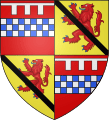Alexander Lindsay, 1st Lord Spynie facts for kids
Alexander Lindsay, 1st Lord Spynie (died 5 June 1607) was an important Scottish nobleman. His death is even mentioned in an old song called Lord Spynie.
Alexander Lindsay was the fourth son of David Lindsay, 10th Earl of Crawford. His mother was Margaret Beaton. From a young age, he became a favorite of James VI of Scotland, who was the king. He was chosen to be a vice-chamberlain, which meant he helped manage the king's household.
A Royal Courtier
In October 1589, Alexander Lindsay traveled with King James VI to Denmark. The king was going there to bring his future wife, Anne of Denmark, back to Scotland. Alexander even lent the king a lot of money, a thousand crowns, for the trip! The king promised to make him a lord when they returned.
Because of this, on 6 May 1590, Alexander received land and the title of Baron Spynie. This meant he became Lord Spynie. He and his wife, Jean Lyon, then lived at Aberdour Castle. They even hosted King James VI and Queen Anne there in December 1590.
Lord Spynie became a new member of the king's special group of advisors, called the privy council, in June 1592. Later that year, he was accused of helping a rebellious nobleman named Francis Stewart, 5th Earl of Bothwell. Lord Spynie offered to fight the person who accused him, but the king said no. After a trial, Lord Spynie was found innocent and set free. However, the king never fully trusted him again.
Challenges and Conflicts
In 1600, a disagreement started between Lord Spynie and another powerful family, the Ogilvies. Even though the king's council tried to stop the fighting, it got worse. On 26 November 1602, the Master of Ogilvie and his brother, along with about 100 armed followers, attacked Lord Spynie's house at Kinblethmont at night.
They used a special device called a petard to blow up the main gate. They also fired cannons at the windows! Then, they went inside the house with their weapons ready. They were looking for Lord Spynie and his wife, but luckily, they had left a few hours before. Since they weren't there, the Ogilvies took many things from the house. King James VI was very upset about this attack. He said that using a petard was so dangerous that no one could feel safe in their own home.
In 1605, when the old bishopric of Moray was brought back, Lord Spynie gave up his rights to the church lands. He did this because the king asked him to.
An Accidental Death
On 5 June 1607, Lord Spynie was in Edinburgh. He saw a fight happening between some of his relatives. He tried to stop the fight and prevent anyone from getting hurt. Sadly, he was accidentally killed by a young man named David Lindsay of Edzell. This sad event was later told in the old ballad Lord Spynie, though the song didn't get all the details right.
His Family
King James VI helped arrange Lord Spynie's marriage to Jean Lyon, Countess of Angus. She was the daughter of John Lyon, 8th Lord Glamis.
Lord Spynie and Jean Lyon had two sons. One was Alexander Lindsay, 2nd Lord Spynie, who inherited his father's title. Their other son, John, died young. They also had two daughters: Anne, who married Sir Robert Graham, and Margaret, who married John Erskine.
Images for kids



